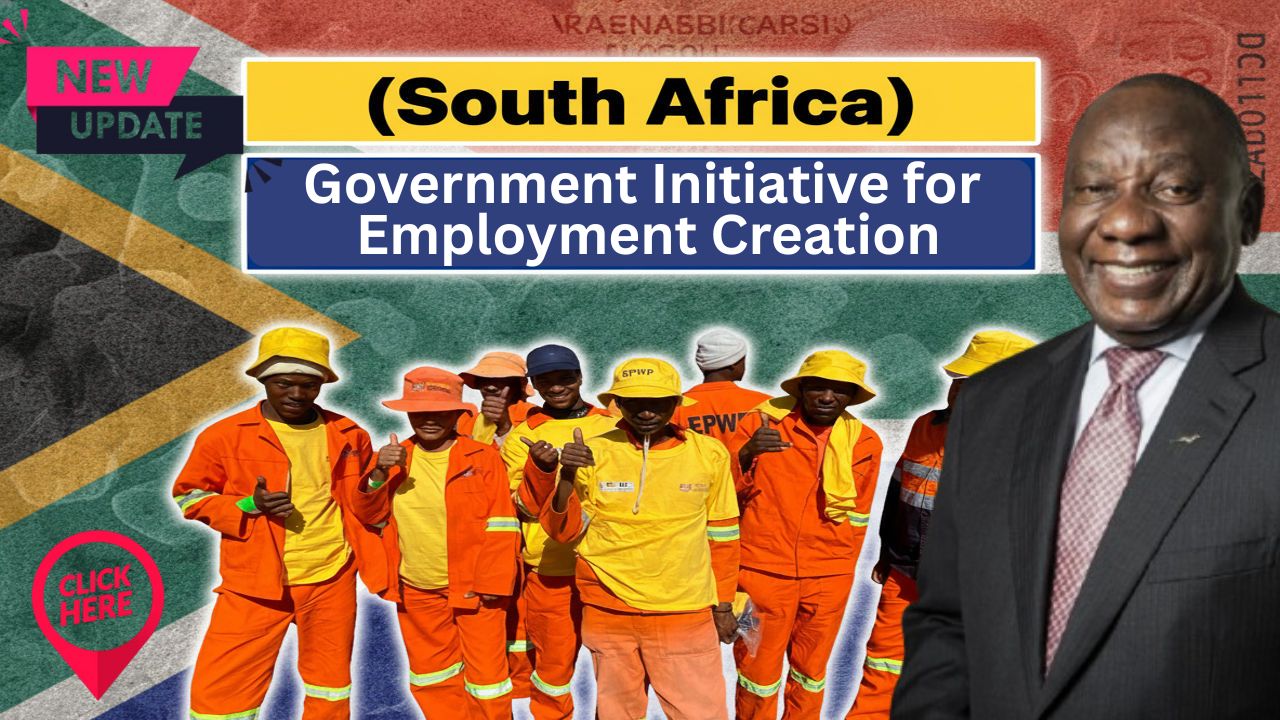South Africa faces a persistent and critical challenge: unemployment rates remain among the highest globally, particularly for youth and women. Recognising this, the national government has launched a comprehensive initiative for employment creation that integrates public employment programmes, private sector incentives, youth work placements, enterprise support and infrastructure-driven job growth. This article presents a clean, well-researched account of that initiative: its components, how it operates, who it targets, benefits and the hurdles ahead.
Government Initiative for Employment Creation (South Africa) Summary Table
Field |
Details |
|---|---|
Name |
Government Initiative for Employment Creation (South Africa) |
Purpose |
To create work and livelihood opportunities, reduce unemployment and support inclusive economic participation |
Key Programmes |
Presidential Employment Stimulus; Community Work Programme; Youth Employment Service; Jobs Fund; Infrastructure-linked employment |
Target Groups |
Unemployed South Africans, youth (18-34), women, persons with disabilities, rural and informal economy participants |
Delivery Mechanism |
Public sector employment programmes, private sector partnerships, enterprise support, skills training, infrastructure projects |
Official Site |
|
Participation Route |
Register on portals, apply for programmes, attend training, meet eligibility criteria for specific schemes |
Outcome Metrics |
Over 1.7 million work and livelihood opportunities created under key stimulus; continuous employment growth recorded |
Key Focus Areas |
Youth employment, enterprise and small business growth, infrastructure development, public-private collaboration |
Why the Initiative Was Launched
South Africas unemployment crisis is deep and multi-dimensional. With an unemployment rate persisting above 30 percent, and youth unemployment even higher, the socio-economic and political risks are substantial. The initiative is intended to address this by creating work-opportunities, not just through passive relief but via active employment programmes that provide income, skills, and pathways into sustainable work. At the same time, boosting employment contributes to economic growth, social stability and inclusive development.
The government recognises that job creation cannot rely solely on transfers or handouts. Instead, the emphasis is on work-based opportunities, enterprise growth and leveraging infrastructure investment to absorb labour, particularly in underserved areas.
Key Components of the Initiative
Presidential Employment Stimulus
This major component was launched to rapidly expand public employment opportunities, particularly in response to shocks such as the pandemic. Since its inception more than 1.7 million work and livelihood opportunities were created, with a heavy focus on youth (83 percent) and women (66 percent).
It supports programmes that scale up quickly, delivering work in sectors such as early childhood development, community services, infrastructure maintenance and environmental tasks.
Community Work Programme (CWP)
The CWP offers predictable local work opportunities in high-unemployment areas, acting as a job-safety net while offering valuable work experience. It aims to engage large numbers of working-age unemployed people through community-based assignments, supported over the medium term with substantial allocations.
Private Sector and Enterprise Support
Recognising the private sector as the primary engine of jobs, the initiative includes support for small, medium and micro-enterprises (SMMEs), youth entrepreneurship, private-sector youth employment placements (e.g., Youth Employment Service) and business environment reforms to reduce barriers to hiring.
Infrastructure and Public Investment
By scaling infrastructure investment and maintenance, the initiative creates labour-absorptive work opportunities. Projects in construction, environmental rehabilitation, public services and local government maintenance are deliberately labour-intensive and locally based to maximise job creation.
How the Initiative Works in Practice
Eligibility and Participation
Programs vary in eligibility, but common criteria include: being unemployed or under-employed; residing locally; meeting age or other special-group requirements (e.g., youth or women); being willing to work and train. Registration is often required through government portals, career-fairs or local municipal offices.
Work Process and Stipends
Selected participants undertake work assignments often structured as fixed-term engagements. They receive a wage or stipend which helps stabilise income. The aim is both to provide immediate relief and to build work-capacity, so individuals can transition to other jobs.
Skills, Training and Exit Strategies
Participants frequently receive training, mentoring and accreditation of their work experiences. This builds their employability beyond the programme itself. The initiative emphasises pathways into longer-term employment or entrepreneurship rather than indefinite temporary work.
Monitoring and Reporting
Government departments monitor job-creation metrics, demographic reach (youth, women, persons with disabilities), project outputs and the quality of assets created. Regular reporting helps assess effectiveness and guide future allocation of resources.
Benefits and Early Outcomes
- Income relief for vulnerable groups: By providing work and wages, the initiative helps many households cope with unemployment and poverty.
- Work-experience and employability: Participants gain experience, routine, and demonstrated work readiness, improving chances of finding formal employment.
- Asset and service creation: The work delivered under the programme contributes to local infrastructure, community services and environmental improvement.
- Inclusive reach: Youth and women in particular have been prioritised, helping address the demographic dimensions of unemployment.
- Economic stimulus: With greater employment comes increased consumption and community-economic activation, contributing to growth and stability.
Challenges and Limitations
Despite many positive features, the initiative faces significant hurdles:
- Temporariness of work: Many opportunities are short-term. Participants may return to unemployment if transition pathways are weak.
- Private-sector absorption: Moving from the programme into sustainable permanent employment remains difficult for many participants.
- Skills mismatch: Training does not always align with labour-market demand or local economic opportunities, limiting impact.
- Structural barriers: High regulatory compliance, transport and spatial-planning issues reduce employment access, especially for disadvantaged groups.
- Data and evaluation gaps: Measuring long-term impacts on employment, income and livelihoods is challenging, making it harder to assess full effectiveness.
- Dependence on public funding: Large scale job creation through public programmes may not be sustainable without strong private-sector growth and investment.
Future Focus and Strategic Directions
The initiative is evolving with a growing emphasis on:
- Linking to enterprise growth and entrepreneurship so that participants develop long-term income streams, not just temporary jobs.
- Green economy and infrastructure such as environmental rehabilitation, renewable-energy jobs and climate-resilient projects, with high labour-absorption potential.
- Improved skills alignment to labour market needs, digital skills, work readiness and pathways into growth sectors.
- Better transition mechanisms ensuring that programme participants can move into formal employment or create their own businesses.
- Regulatory and business-environment reform to reduce hiring costs, simplify registration of business, improve transport and spatial access to jobs.
- Enhanced monitoring and evaluation focused not only on number of opportunities but also longer-term employment outcomes and livelihoods improvements.
Frequently Asked Questions (FAQs)
What is the core goal of the employment-creation initiative?
The goal is to create work and livelihood opportunities for unemployed South Africans, especially youth and women, while supporting economic growth and inclusion.
Who can participate in the work programmes?
Eligible participants typically include unemployed or under-employed persons resident in project areas, with priority for youth (18-34), women and persons with disabilities. Specific criteria vary by programme.
Is the work guaranteed permanent employment?
No. The positions are generally temporary work opportunities. However the initiative includes training and support to help participants move into longer-term employment or entrepreneurship.
How can one apply?
Individuals should register on government portals or through local municipal offices, attend advertised drives or career fairs, meet eligibility criteria and apply when specific programmes or work opportunities are announced.
What sectors does the initiative focus on?
Key sectors include public employment programmes, infrastructure development, environmental management, community services, youth employment placements and enterprise support.
Where can I find official information?
Official information is available on the government jobs-creation page: https://www.gov.za/issues/job-creation
Conclusion
South Africa government initiative for employment creation offers a comprehensive, multi-pronged approach to one of the nation most serious challenges. By combining public employment programmes, youth-work placements, enterprise support and infrastructure investment, it seeks to create meaningful opportunities for those excluded from the workforce. While formidable structural obstacles remain, the initiative provides income, experience and pathways for millions, and the future focus on sustainability, skills and private-sector absorption offers hope for deeper and enduring impact. For individuals seeking work, staying aware of programmes, preparing for training and applying early are key to benefiting from this initiative.
For More Information Click Here








